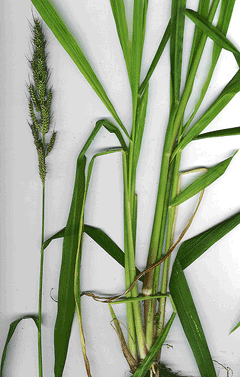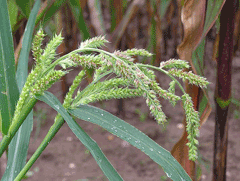 |
|
http://www.hear.org/starr/ |
 |
| http://commons.wikimedia.org/wiki/User:Mbc |
Translate this page:
Summary
Physical Characteristics

 Echinochloa crus-galli is a ANNUAL growing to 1.2 m (4ft) by 0.2 m (0ft 8in).
Echinochloa crus-galli is a ANNUAL growing to 1.2 m (4ft) by 0.2 m (0ft 8in).
See above for USDA hardiness. It is hardy to UK zone 6. It is in flower from July to September, and the seeds ripen from August to October. The species is hermaphrodite (has both male and female organs) and is pollinated by Wind.
Suitable for: light (sandy), medium (loamy) and heavy (clay) soils and prefers well-drained soil. Suitable pH: mildly acid, neutral and basic (mildly alkaline) soils and can grow in very alkaline soils.
It cannot grow in the shade. It prefers moist soil. The plant can tolerates strong winds but not maritime exposure.
UK Hardiness Map
US Hardiness Map
Synonyms
Panicum crus-galli
Plant Habitats
Cultivated Beds;
Edible Uses
Edible Parts: Leaves Seed Shoots
Edible Uses: Coffee
Seed - cooked[35, 55, 105, 171]. Used as a millet, it can be cooked whole or be ground into a flour before use[183, 257]. It has a good flavour[85] and can be used in porridges, macaroni, dumplings etc[183]. The seed is rather small[159], though fairly easy to harvest. It has a somewhat bitter flavour[178]. Young shoots, stem tips and the heart of the culm - raw or cooked[144, 177]. A nutritional analysis is available[218]. The roasted seed is a coffee substitute[177].
References More on Edible Uses
| Composition
|
| Figures in grams (g) or miligrams (mg) per 100g of food.
|
|
|
Leaves (Dry weight)
|
|
- 0 Calories per 100g
- Water : 0%
- Protein: 7.4g; Fat: 2.9g; Carbohydrate: 81.1g; Fibre: 31.3g; Ash: 8.6g;
- Minerals - Calcium: 0mg; Phosphorus: 0mg; Iron: 0mg; Magnesium: 0mg; Sodium: 0mg; Potassium: 0mg; Zinc: 0mg;
- Vitamins - A: 0mg; Thiamine (B1): 0mg; Riboflavin (B2): 0mg; Niacin: 0mg; B6: 0mg; C: 0mg;
- Reference: [ 218]
- Notes:
|
|
Medicinal Uses
Plants For A Future can not take any responsibility for any adverse effects from the use of plants. Always seek advice from a professional before using a plant medicinally.
Styptic Tonic
Reported to be preventative and tonic, barnyard grass is a folk remedy for treating carbuncles, haemorrhages, sores, spleen trouble, cancer and wounds[269]. The shoots and/or the roots are applied as a styptic to wounds[218, 240]. The plant is a tonic, acting on the spleen[218, 240].
References More on Medicinal Uses
The Bookshop: Edible Plant Books
Our Latest books on Perennial Plants For Food Forests and Permaculture Gardens in paperback or digital formats.

Edible Tropical Plants
Food Forest Plants for Hotter Conditions: 250+ Plants For Tropical Food Forests & Permaculture Gardens.
More

Edible Temperate Plants
Plants for Your Food Forest: 500 Plants for Temperate Food Forests & Permaculture Gardens.
More

More Books
PFAF have eight books available in paperback and digital formats. Browse the shop for more information.
Shop Now
Other Uses
Soil reclamation
The plant is sometimes used, especially in Egypt, for the reclamation of saline and alkaline areas[269].
Special Uses
References More on Other Uses
Cultivation details
An easily grown plant, it is adapted to nearly all types of wet places, and is often a common weed in paddy fields, roadsides, cultivated areas, and fallow fields[269]. It succeeds on a variety of wet sites such as ditches, low areas in fertile croplands and wet wastes, often growing in water[269]. It succeeds in cool regions, but is better adapted to areas where the average annual temperature is 14-16°C[269]. Tolerant of most soil types, including saline conditions, plants are not restricted by soil pH[269]. Prefers a rich moist soil[85] but succeeds in ordinary garden soil[1]. The sub-species E. crus-galli zelayensis (HBK)Hitchc. is often found growing wild in alkaline soils[236]. The plant is reported to tolerate an annual precipitation in the range of 31 to 250cm, an annual temperature range of 5.7 to 27.8°C and a pH in the range of 4.8 to 8.2[269]. Barnyard millet is sometimes cultivated for its edible seed in India[171]. It has a relatively long growing season and does not always ripen its seed in Britain, though it should do better in the eastern half of the country[K]. The plant is considered to be a very serious weed of many cultivated crops[269].
References Carbon Farming Information and Carbon Sequestration Information
Temperature Converter
Type a value in the Celsius field to convert the value to Fahrenheit:
Fahrenheit:
The PFAF Bookshop
Plants For A Future have a number of books available in paperback and digital form. Book titles include Edible Plants, Edible Perennials, Edible Trees,Edible Shrubs, Woodland Gardening, and Temperate Food Forest Plants. Our new book is Food Forest Plants For Hotter Conditions (Tropical and Sub-Tropical).
Shop Now
Plant Propagation
Seed - sow early spring in a greenhouse and only just cover the seed. When they are large enough to handle, prick the seedlings out into individual pots and plant them out into their permanent positions in early summer. A sowing in situ in late spring might also succeed but is unlikely to ripen a crop of seed if the summer is cool and wet.
Other Names
If available other names are mentioned here
Native Range
EUROPE: Russian Federation (Kalmykija, Respublika, Astrakhan, Saratov, Volgogradskaja oblast)
Weed Potential
Right plant wrong place. We are currently updating this section.
Please note that a plant may be invasive in one area but may not in your area so it's worth checking.
Conservation Status
IUCN Red List of Threatened Plants Status :

Growth: S = slow M = medium F = fast. Soil: L = light (sandy) M = medium H = heavy (clay). pH: A = acid N = neutral B = basic (alkaline). Shade: F = full shade S = semi-shade N = no shade. Moisture: D = dry M = Moist We = wet Wa = water.
Now available:
Food Forest Plants for Mediterranean Conditions
350+ Perennial Plants For Mediterranean and Drier Food Forests and Permaculture Gardens.
[Paperback and eBook]
This is the third in Plants For A Future's series of plant guides for food forests tailored to
specific climate zones. Following volumes on temperate and tropical ecosystems, this book focuses
on species suited to Mediterranean conditions—regions with hot, dry summers and cool, wet winters,
often facing the added challenge of climate change.
Read More
Expert comment
Author
(L.)P.Beauv.
Botanical References
50200236
Links / References
For a list of references used on this page please go here
Readers comment
| Add a comment |
|
If you have important information about this plant that may help other users please add a comment or link below. Only comments or links that are felt to be directly relevant to a plant will be included. If you think a comment/link or information contained on this page is inaccurate or misleading we would welcome your feedback at [email protected]. If you have questions about a plant please use the Forum on this website as we do not have the resources to answer questions ourselves.
* Please note: the comments by website users are not necessarily those held by PFAF and may give misleading or inaccurate information.
To leave a comment please Register or login here All comments need to be approved so will not appear immediately.
|
Subject : Echinochloa crus-galli
|
|
|
|